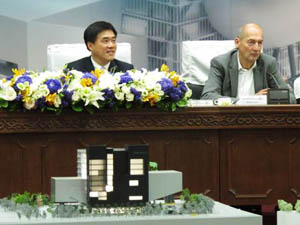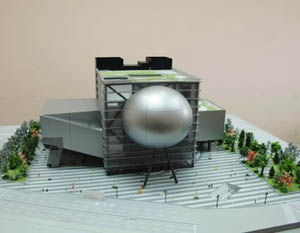Building of Taipei Performing Arts Center due for completion in 2014
By Yali Chen Rem Koolhaas, one of the OMA partners, gave a briefing on their project to Taipei City Mayor Hau Lung-bin on June 17, 2011, after they won the first prize in the design competition to build the Taipei Performing Arts Center in 2009. The construction with a budget of NT$6 billion (US$208 million) is expected to begin in 2012, Hau said, adding that he believes the center will become one of the newest landmarks in Taipei after its completion. Koolhaas took inspiration from the Shilin Night Market, well-known for its local foods such as stinky tofu and tofu with thousand-year-old egg, so he decided to add a Taiwanese touch to his design. The project, led by Koolhaas and his partner Ole Scheeren, includes a 1,500 seat theater and two 800 seat theaters which are plugged into a central cube clad in corrugated glass. This scheme puts all the stage accommodations of the 3 theaters into the central cube, allowing for more flexibility that each theater can be used independently or in combination with the others. In Asia, OMA is working on the office’s largest project to date, the China Central Television (CCTV) Headquarters and Television Cultural Center (TVCC) in Beijing. Both are set to be completed this year.
STAFF REPORTER Taipei City Government plans to build a new performing arts center near the Shilin Night Market, one of the most famous night markets in Taipei. The construction project led by the Office for Metropolitan Architecture (OMA) is due for completion in 2014 and for test-run in 2015.
Taipei City Government plans to build a new performing arts center near the Shilin Night Market, one of the most famous night markets in Taipei. The construction project led by the Office for Metropolitan Architecture (OMA) is due for completion in 2014 and for test-run in 2015. Connecting the different theaters offers new, experimental theatrical possibilities. A public trajectory inside the cube exposes parts of the backstage areas which are usually hidden in typical theaters. This new arrangement of stage and seating includes a public circulation that exposes parts of the backstage to the public.
Connecting the different theaters offers new, experimental theatrical possibilities. A public trajectory inside the cube exposes parts of the backstage areas which are usually hidden in typical theaters. This new arrangement of stage and seating includes a public circulation that exposes parts of the backstage to the public.

![Taiwan.gov.tw [ open a new window]](/images/egov.png)
